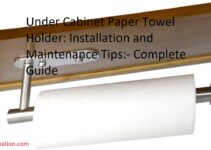Are you concerned about how to pick the perfect under cabinet range hood for your kitchen? You don’t need to worry anymore!
This guide has everything you need to look for when choosing the right one, helping you make an informed decision. Let’s get started and explore the essential features of a quality range hood.
When it comes to your kitchen, there are few features more essential than a good range hood. A range hood, sometimes referred to as an over-the-range microwave or OTR (for short), is a device that fits above your stove/range and helps you keep the kitchen clean by filtering grease and smoke from the air. With so many types of range hoods on the market, it’s important to make sure you purchase the right one for your kitchen.
In this article, we will discuss everything you need to know when choosing an under cabinet range hood for your kitchen. We’ll cover topics such as measuring for size and height, materials used, exhaust options, noise levels, ventilation codes and installation methods. Once you’ve finished reading this guide you’ll have all the information necessary to make an informed decision about your new under cabinet range hood!
Types of Under Cabinet Range Hoods
When it comes to selecting an under cabinet range hood, there are several types available on the market. Before making a decision, it is important to consider the type of hood that will best fit into your kitchen design and also meet your ventilation needs. Here is a guide to help you choose the perfect type for your home.
- Types of Under Cabinet Range Hoods
The most common types of under cabinet range hoods are: vented, ductless, wall-mounted and island range hoods. Each has unique features and benefits that should be taken into consideration when purchasing.
Vented range hoods: These are probably the most popular style. Vented range hoods require duct work and connect directly to an external vent in order to exhaust air outside of your home’s structure. This type of range hood provides better airflow than other types as it circulates much more air than ductless designs while ensuring quiet operation as well as efficient filtration.
Ductless range hoods: This type is designed to be used in kitchens not reliable on external ventilation systems since they do not require any ductwork for installation or extra filters for maintenance/ cleaning purposes due to its internal charcoal filter which can nebulize oils and odors from cooking. Also, because they contain multiple fans, this design ensures quieter operation than traditional models by pushing cooking fumes away from its source at multiple speeds so you can control its power while cooking according to food type or quantity being cooked at the same time!
Wall-mounted range hoods: These models offer a great space saving solution since they are usually installed on walls instead of under cabinets like other types mentioned above; however their power may vary depending on where they’re placed near windows or vents as these open spaces make them less effective due limitation in effectiveness due outside air exchange. In addition; these models provide better ventilation than standard styles thanks to their larger size area capture over countertop appliances! Some units even feature built-in lights which make them an ideal choice if you’re looking for a stylish lighting solution too!
Island Range Hoods: Island Range Hoods are used widely when compared with other styles since their placement does not occupy valuable countertop space since or block kitchen views unlike other designs- this helps promote openness desired in modern kitchens; but at same time enable efficient removal odors…A lot of times comes with additional cooling fans making them ideal option hot summer days where large family meals call simultaneous frying bottles etc….This style also offers greater versatility since come different colors/ finishes suiting most décor preferences.
Ducted range hoods
Ducted range hoods are the most powerful and effective units you can install in your kitchen, as they are fitted with a duct that leads to the exterior of your home — usually near a window — to remove smoke and odors.
This type of range hood is equipped with a fan that forces the air from your cooking area outside, making them extremely efficient at trapping grease, odors and other airborne particles that may result during cooking. Ducted range hoods are available in diverse sizes, designs and styles.
When selecting one for your kitchen, make sure it has sufficient airflow (measured in cubic feet per minute), a powerful motor and quality construction. Some models even allow you to adjust the fan speed to suit specific requirements when cooking.
Depending on design and size, ducted range hoods can be quite costly but are worth investing in as they provide superior efficiency compared to recirculating models.
Ductless range hoods
Ductless range hoods, also referred to as recirculating range hoods, don’t draw air outside. Instead, they trap it, pass it through a filter and then release the filtered air back into your kitchen. This type of venting is ideal for apartments and homes without ventilation ducts. Most ductless range hoods are designed to be installed beneath or mounted above your stove.
Like their vented counterparts, these models typically comeinwidths that correspond with the size of your oven or stovetop and feature lights and adjustable-speed fans for efficient air filtration. The filters used to clean the air differ from their vented counterparts. If you opt for a ductless model, look for units that feature washable mesh filters instead of charcoal ones since mesh filters provide better catch-and-release performance and are more hassle free to replace since they are dishwasher safe.
Factors to Consider When Choosing an Under Cabinet Range Hood
When you begin your search for an under cabinet range hood, there are a few factors to consider that will help you choose the best one for your needs. Here are some of the top considerations:
-Size: The hood size should be proportional to your kitchen size and stove burner size. Under cabinet range hoods typically come in widths ranging from 24-36 inches to fit standard cooktop sizes.
-Noise level: Many manufacturers provide CFM ratings – cubic feet per minute – that indicates how much air is being moved through the hood, and therefore, how noisy it is likely to be. Look for features such as sound baffles or noise dampening material on a range hood if noise levels are important to you.
-Lighting: Some under cabinet range hoods feature LED lighting strips along their bottom edge so you can clearly see when cooking in low light conditions. Some also feature interior lighting along with digital controls and LCD displays so you can easily monitor temperature levels and fan speeds.
-Heat sensitivity settings: Heat sensing settings allow the fan speed on an under cabinet range hood to automatically increase if steam, smoke or heat builds up in the kitchen environment. This ensures proper ventilation even during peak cooking times.
Kitchen Size
When choosing a range hood, one of the most important factors to consider is your kitchen size. The size and layout of your kitchen will determine what type and size of range hood you need.
The general rule to follow when purchasing an under cabinet range hood is that it should cover at least 50% of the cooktop surface area, with a minimum width of 30 inches for a standard 36-inch cooktop. You also want to make sure that your new range hood has enough power for continuous ventilation.
To determine how much power you need, measure the amount of air that needs to be moved in cubic feet per minute (CFM), then add it up based on the number and size of burners on your cooktop.
Hood Size and CFM
When looking for the right range hood for your kitchen, an important consideration is the size and CFM rating of your hood. Generally, the larger the space in your kitchen and the more powerful stove/cooktop you have, the higher CFM (Cubic Feet Per Minute) you will need in order to efficiently remove odor and smoke from your cooking. Generally, a good rule of thumb to calculate hood size is 100CFM per linear foot of cooking surface if using a gas stove or cooktop and 150-200CFM per linear foot if using an electric cooktop/stove. As with all appliances, allowances should be made for any specific instructions provided by the manufacturer.
When selecting a range hood that is right for your kitchen setup, it’s important to make sure that it has enough capacity to adequately clean the air in your kitchen. If you choose a hood with insufficient amount of CFM, it will not be able to effectively remove the unwanted odors, smoke and steam generated when cooking which could cause an accumulation of grease in your kitchen space. Additionally, higher CFMs may help generate optimal airflow which can lead to more efficient cooling during summer months as well as better indoor air quality overall.
In summary, picking a range hood with appropriate size and sufficient CFM is essential if you want an effective odor control system in your kitchen!
Noise Level
Noise level is an important factor to consider when buying a range hood. If you plan to spend a lot of time in the kitchen and will be using the range hood on a regular basis, then you want to make sure it is operating quietly. Generally, range hoods are rated according to their decibel (dB) level. The unit of measure for noise is logarithmic, so the addition of 3 dB equals actually doubling in sound.
The quieter your range hood is, the less likely it will be to disturb conversations or disrupt other activities happening in your home. Most motors are capable of running with approximately 300 CFM at a 5 Sones noise level rating (the equivalent of 53 dB). When choosing your range hood, look for models with lower Sones ratings and make sure they include special silent or low-noise fan settings that help reduce noise levels while in use.
Installation and Maintenance of Under Cabinet Range Hoods
Installation of an under cabinet range hood can be a fairly straightforward process, but there are some details that need to be taken into consideration. The most common type of range hood is the ducted variety, which requires a dedicated hole in the wall or roof of your home as well as an adjustable-sized ducting pipe. If you don’t have an existing vent hole, you may need to employ the services of a professional contractor to drill one for you. Additionally, the vent pipe connecting it to the outside of your home may also require professional help if it includes cutting through walls and ceilings.
It’s important to note that installing cooker hoods involves securely fixing them in place. Most under cabinet range hoods can be easily fixed directly onto two existing wall studs or mounting on a flat ceiling above Kitchen counter top.
In addition, to ensure proper functioning and operation maintenance over time should also be carried out regularly by checking filter elements (charcoal filters and grease filters) and ensuring they are properly clean and replace with new ones when necessary. To prevent any reaction with kitchen smoke it is good practice to clean inside as well as outside fully every once in month using lukewarm soapy water or simply use neutral cleaners available in stores.
Installation considerations
When selecting a range hood for your kitchen, it is important to consider the type of installation you will need for the space. Range hoods come in several different installation types, including under cabinet, wall-mounted, ceiling-mounted and island mount.
Installation considerations include clearance above the range top, space restrictions under cabinets or how much area is available around the exhaust fan opening in the ceiling. So, before you buy a range hood, measure your kitchen carefully and make sure you have enough space to accommodate both the range hood itself and any fittings required for installation.
Under cabinet range hoods tend to be more compact since they are meant to fit beneath cabinetry above stovetops or ranges. It is important to check that there is enough clearance between your chosen model and overhead cabinetry—you don’t want your newly purchased range hood to be blocked by cabinet doors!
It’s a good idea to look for an adjustable ventilator that can be adjusted as needed; this allows you more flexibility when it comes time for installation.

Maintenance and cleaning tips
When it comes to maintaining and cleaning your under cabinet range hood, you may be tempted to simply toss it in the dishwasher for a thorough deep clean. However, this could lead to permanent damage to your appliance, so if you want a long-lasting working range hood, never put the fan motor or filter in the dishwasher.
Aside from that, there are several other tips that can help ensure your range hood can perform throughout its life:
- Make sure you check your filter every two months and clean it with a grease cutting agent or throw it away if it’s soiled beyond repair.
- Always use a wood or plastic blade when you’re cleaning around sensitive components since metal blades can cause scratching or other damage.
- Using compressed air is another convenient way of keeping the air vent clean and free from blockage.
- Try not to use too much heat when cleaning components as this can also cause damage over time.
- If using steam to remove any grease from fan blades or motors, allow the components time to cool off before switching them back on again after cleaning them with either water or steam mop machine will do amazingly well in that matter as well.
Conclusion
Choosing a range hood for your kitchen is an important decision. It can be tricky to find one that fits your requirements, but with the right considerations, you should be able to find a suitable product.
Think about what type of range hood would work best in your kitchen based on their various designs and features. In addition, remember to consider the exhaust system that would work best in your kitchen design prior to making your purchase.
With all these factors taken into account, you will end up with a range hood that provides the right balance between being functional and aesthetically pleasing in terms of design for both short-term ease of use and long-term satisfaction.
FAQ’s
How do I choose an under cabinet range hood?
When choosing an under cabinet range hood, consider factors such as the size of the hood, the airflow, the noise level, and the filter type. Make sure the hood is the correct size for your range, is powerful enough to clear smoke and odors, and produces minimal noise. Additionally, ensure that the filter type is easy to clean and replace.
How do I choose a range hood for my kitchen?
When choosing a range hood for your kitchen, consider the size of your stove and the layout of your kitchen. You may also want to consider the type of range hood, such as under-cabinet, island, wall-mounted, and ventless hoods. Additionally, think about what type of ventilation capabilities you need, such as adjustable fan speeds and venting duct designs.
What size under cabinet range hood do I need?
The size of a range hood depends on the size of your stove. Generally speaking, a range hood 2 inches wider than your stove provides the best coverage.
Should range hood match cabinets or stove?
It is recommended that the range hood should match the cabinets and stove.
Which range hood is best for californian cooking?
The best range hood for Californian cooking is a vented, wall-mounted hood with an internal or remote blower that offers a minimum of 600 CFM (cubic feet per minute). Additionally, it is important to select a hood that is capable of properly venting the steam, odors and smoke created when cooking high-temperature dishes.
Which type of kitchen hood is better?
It depends on a variety of factors, including the size of your kitchen, the type of cooking you do, noise levels, design features, and energy efficiency. Generally, ducted range hoods are more effective at removing cooking odors, grease, and humidity than ductless range hoods.
Is higher CFM better for range hood?
Yes, higher CFM (cubic feet per minute) is better for a range hood since it directly affects the air flow rate and helps to better capture smoke, steam, and odors produced in the kitchen.
How do I know what size range hood to buy?
Determine the size of your range hood by measuring the width of your range and adding 3 to 6 inches to your measurement.
What are the different types of under cabinet range hoods?
There are four main types of under cabinet range hoods: ducted hoods, convertible hoods, insert hoods, and top- or wall-mounted hoods. Ducted hoods are connected to an external ventilation system, whereas convertible hoods can be switched between ducted and non-ducted operations. Insert hoods are installed into an existing cabinet and are typically used in island or peninsula-style kitchen designs. Top- or wall-mounted hoods are secured to either a wall or cabinet, but are not recessed into the cabinet.
What is the best height for under cabinet range hood?
The best height for an under cabinet range hood is 24 to 30 inches above the cooktop.
See more-
- Best sewing cabinet 2023
- Best medicine cabinet 2023
- Best outdoor storage cabinet 2023
- Best under cabinet lighting battery 2023
- Best cabinet liners 2023


